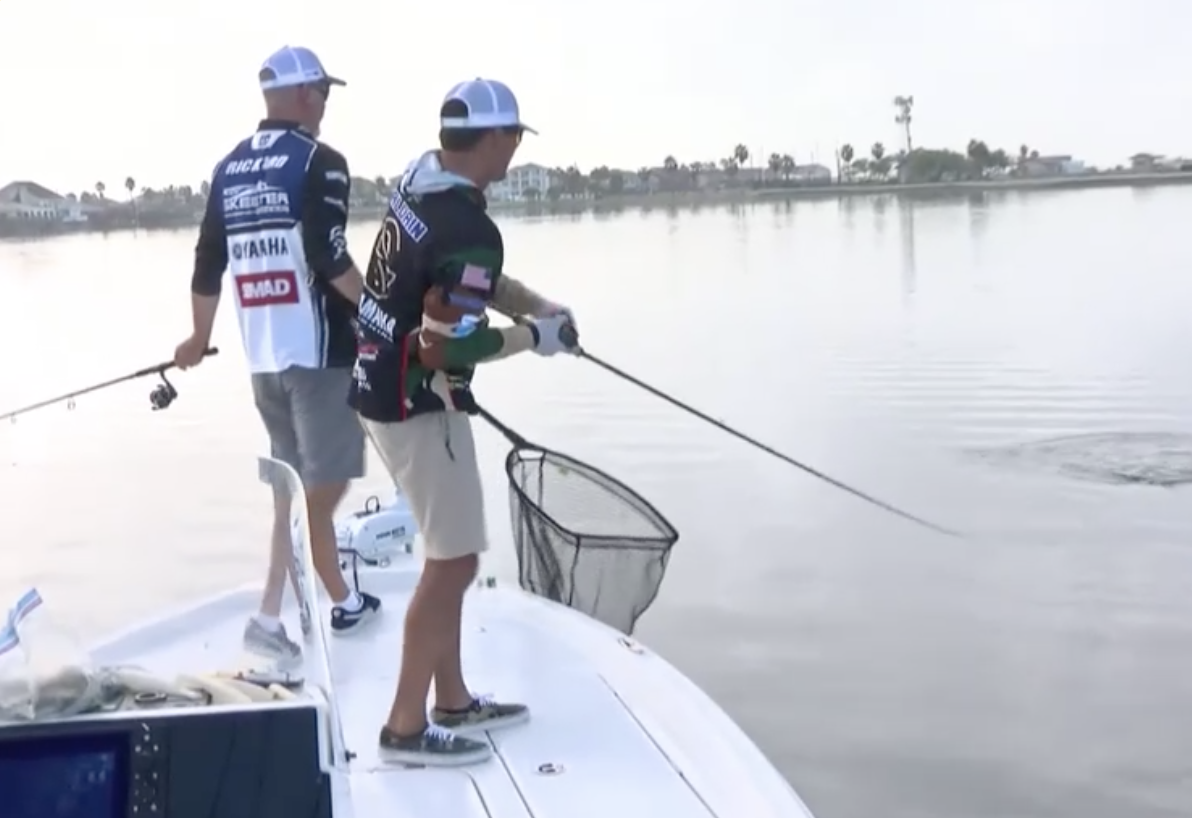
For two days, the 10 teams searching for Lone Star redfish have contended with dim conditions and strong winds. Day 1 brought a southeast blow of 15-20 mph and Saturday saw a switch to the northeast bringing as much, or more.
Day 3 dawned with cloudy skies that quickly yielded to the early sun’s warming brilliance. No need for the jackets and bibs many wore well into the second day’s afternoon hours; but the biggest difference — likely the most impactful in the long term — is the final round’s nearly flat calm conditions.
Wind direction has shifted back to a southeasterly angle and that balmy breeze is projected at 3-9 mph.
Warm, muggy air, generous illumination, still water — Texas has served up an enviable scenario for finding red gold.
The fish bit well on Day 1, but the cooler northeast wind edged the aggression and the overall productivity dipped. Today’s scenario will likely offer the event’s greatest opportunity, as the redfish that took a break during yesterday’s unfavorable complexion will be driven by rumbling bellies.
As of 9:45 Central Time, defending champions, Bassmaster Elite veteran Chris Zaldain and IFA Redfish Tour standout Ryan Rickard held the unofficial lead with two fish for 10-5. After boating their second keeper, Zaldain noted a clear morning feed.
“The speed that both of those fish were moving on the flat, I could tell they were hunting — 100 percent,” he said.
Considerations
Strategies will vary team to team, but the fundamentals of today’s weather bear a few broadly applicable truths.
The upside: Calm plus sun equals significantly improved visibility. This will benefit everyone, but Elite Series champion and 2019 Rookie of the Year Drew Cook and Elite Redfish Series pro Kevin Akin said the Day-3 conditions will greatly impact their game plan.
“That’s been a big deal for us — trying to look for them and catch them,” Cook said. “If I had to pick one way I’d like to catch redfish, it would have to be 100 percent looking at them, sight fishing. That’s my favorite thing to do in bass fishing too, so hopefully, with more sun (today) they’ll be floating around and we can catch them.”
Akins agreed: “If we get a little sun it will change a lot for us. We’ve been waiting for sun the entire event.”
Elsewhere, 2022 Redfish World Series champions Sean O’Connell and Edward Adams, who led the first two days, lamented missed opportunities when they spotted “floaters” — redfish suspending below the surface — too late to capitalize with short, targeted casts. Today’s greater visibility should allow them to spot these targets off opportunity much sooner.
The downside: If you can see the fish, they can see you, so a calm day with great visibility balances opportunity with obligation — specifically, stealthy movement.
Also, while the strong winds of days 1 and 2 presented challenges, the blow provided natural propulsion for the long drifts that led O’Connell and Edward Adams to their fish. They basically played a numbers game, in which they could count on two to three bites per drift, buy today’s conditions takes that strategy off the table.
Trolling motors are the obvious option and many teams are using theirs. However, even the brash, aggressive redfish gets nervous in shallow water and they hear everything.
Staking out a productive area with shallow water anchoring devices such as the Minn Kota Talons or Raptors works for a time, but you have to cover water to find something worth a pause.
What to throw
In addition to boat noise, bait choice will be critical today. In the early goings, Zaldain was throwing a rattling glide bait in hopes of tempting a big bite (straight-up bass tactics, right there). Not a bad idea, but his partner noted a potential drawback.
“It might have too much rattle,” Rickard said, to Zaldain’s agreement.
Switching to a silent soft body swimbait, Zaldain found better results. This tactic delivered several big bites during their 2021 win.
One thing these calm conditions will offer is an all-day topwater bite. Unlike largemouth bass, which often shy away from the surface deal after the early morning hours, reds will crush topwaters from sunup to sundown — especially when calm water facilitates their targeting.
Case in point: Around 9:25, O’Connell’s walking bait disappeared in a frothy explosion. Unfortunately, that fish measured well over the 28-inch maximum length, but the super aggressive bite told the tale of topwater opportunity.
Many are the calculations of redfish tournament anglers and, despite how rapacious these appetite-driven fish can be, it’s not a gimme. Port Aransas unquestionably merits its title “Fishing Capital of Texas”, so the local reds have seen a lot of lures.
These fish may, at times, act like a bunch of gluttonous dummies, but they really aren’t. Then again, neither are the 20 anglers looking for them.
We’ll have to wait and see who wins this briny chess match.





